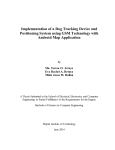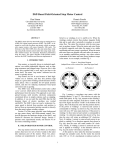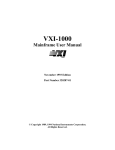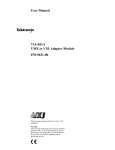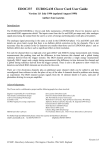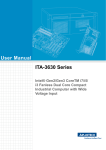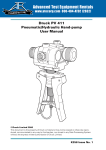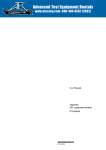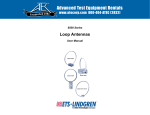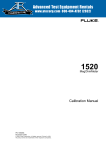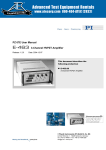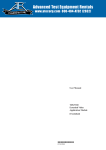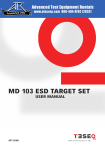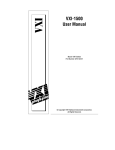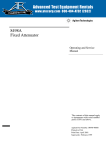Download 02 GPT cat body 2 - Advanced Test Equipment Rentals
Transcript
® Advanced Test Equipment Rentals E stablished 1981 www.atecorp.com 800-404-ATEC (2832) Models 296 and 295 50 MS/s Synthesized Multichannel Arbitrary Waveform Generators ◆ Up to 4 Independent Channels ◆ 10 Standard Functions (sine to 20 MHz, square to 25 MHz) ◆ Up to 50 MS/s Sampling with 12-Bit Vertical Resolution ◆ Waveform Sequencing of up to 4,096 Segments (Model 296 only) ◆ Frequency Control of Individual Sequence Segments (Model 296 only) ◆ 16-Bit Digital Output to 50 MS/s (Model 296 only) ◆ Optional 100 Vpp Output ◆ Versatile Interchannel Triggering, Summing and Phase Control ◆ Frequency Sweep ◆ Amplitude and Suppressed Carrier Modulation ◆ Graphical User Interface ◆ Front Panel Waveform Creation/Editing Tools ◆ Floppy Disk Drive ◆ GPIB and RS-232 Interfaces ◆ Compatible with Waveform DSP ◆ SCPI Compatible M odels 296 and 295 combine sophisticated performance with ease of use in a way previously not available in arbitrary waveform generators. Model 295 is the basic model. Model 296 adds advanced waveform sequencing capability up to 4,096 waveform segments for complex waveform generation. It also provides a 16 bit digital output on each channel. Both models can contain up to four separate channels. When run independently, each channel is essentially a stand-alone arbitrary waveform generator. When in master/slave mode, phase relationships between channels can be set by the user. Each channel outputs 15 Vp-p (into 50 Ω load) at 50 MS/s sampling frequency maximum or can output 100 volts peak-topeak when Option 007 is installed. Each channel has a high-speed clock output that runs at a maximum of 100 MHz. Arbitrary waveforms can be created and stored to nonvolatile RAM or on the standard MS-DOS™ compatible 3.5-inch, high-density disk drive. In addition, ten commonly used synthesized functions are built in. The graphic user interface greatly simplifies creating and editing waveforms, which can be viewed on an oscilloscope. A mouse (provided) is used to draw on a scope when creating waveforms and to make selections on the graphical interface when setting up the instrument. Arbitrary waveforms may be created from the front panel using the mouse and any of four modes: free hand, line draw, line list, and mathematical expressions. In addition, extensive waveform editing tools enable the user to control waveform shapes precisely. The editing tools make it easy to modify existing waveforms. This is particularly useful in such applications as characterization testing. For instance, amplitude may be modified continually in order to characterize performance of the unit under test. For more complex applications, waveform linking, looping and sequencing allow users to create long, complex waveforms. Versatile interchannel capabilities are provided. An internal summing bus allows waveforms from multiple channels to be summed together. Other interchannel capabilities include setting phase shift between channels, linking waveforms together and triggering one channel from another. Waveforms, sequences, and entire instrument set-ups can be stored in the internal nonvolatile 60 kB RAM or on disk via the disk drive. It’s Easy to Create Any Waveform. Models 296 and 295 take the limits off your ability to simulate the signals you are faced with in the real world. Built-in features make interactive control of complex waveforms and instrument set-up simple. Waveforms can be created, copied, edited, downloaded, and sequenced, all with a few clicks of the mouse. The 296 and 295 provide a complete set of tools that enables you to specify all kinds of waveforms in a number of ways, from precise mathematical description to “what-if” freehand sketching. And modifying waveforms is a snap with tools such as Vertical Resize and Vertical Move. The sophisticated user interface gives you access to all the power of the 296 and 295, with a flexibility in waveform creation never before 5 Model 296 Typical math expression screen. Scope Edit screen. Summing screen. Amplitude modulated signal generated by the expression shown on the math expression screen above. Scope shows waveforms created with Line Draw/Line List (top) and Freehand Draw (bottom). Scope illustrates summing. Top: Clean square wave. Middle: Noise. Bottom: Summed waveform (square wave with noise). tude and time value. For other kinds of applications, Freehand Draw gives the flexibility of using the mouse to draw a waveform on the oscilloscope in much the same way as with a pencil on paper. This makes tasks like inserting spikes on waveforms easy. Sum Multiple Channels to Create Complex Waveforms. With the internal analog sumbus, you can sum waveforms from two channels together and output the sum as a complex or modulated waveform. The optional high voltage and external summing module allows three channels and an external signal to be summed. Create Long, Complex Waveforms with Linked Sequence Operation. Up to 4,096 waveforms can be linked together with the Model 296. Up to 4 waveforms can be linked together with the Model 295. Loop count and advance conditions for each waveform are user programmable. Trigger Operation. Each channel has its own internal trigger generator and external trigger input. Multiple channel triggering and versatile interchannel triggering are also provided. More Tools Make Editing Easy. Models 296 and 295 give you easy ways to modify waveforms you’ve created. For example, you can copy and insert portions of existing waveforms, move individual waveform points, and increase or decrease the amplitude of all or part of the waveform. Digital Output (296 only). Each channel provides a 16-bit digital output programmable to 50 MHz. available. An internal memory of 60 kB is provided for storing the waveforms you create. Storing waveforms created or captured elsewhere is no problem either. Simply download waveforms over the GPIB or RS-232 interface or through the standard 3.5-in disk drive. You can download waveforms generated in Wavetek’s WaveForm DSP arbitrary waveform creation software or directly from a DSO (with Option 005). Or use the disk drive to load ASCII files generated from spreadsheet programs such as Microsoft Excel® or Borland’s Quattro Pro®. Use Math Expressions. You can create waveforms with mathematical precision by entering math expressions using the numerical keys on the front panel. Use Line Draw/Line List and Freehand Draw. For waveforms with straight lines, as in pulse or digital applications, Line Draw allows you to use the mouse to draw the lines on an oscilloscope. Lines may also be created using Line List, which allows you to enter the vertices of each line with ampli- Specifications NOTE: Specifications apply after a 20-minute warm-up. Standard Waveforms Sine, square, triangle, pseudo-random noise, positive ramp, negative ramp, positive haversine, negative haversine, sin x/x and DC. 6 Model 296 Digital Output (296 only) 16-bit differential ECL updated at up to 50 MHz. Frequency Range: 0.2 Hz to 50 MHz Resolution: 5 digits or 0.1 mHz Screen shows waveforms, loop counts, and advance conditions in a typical sequence. Screen shows typical trigger set-up. In this case, channel 2 will trigger channel 1. Clock Output (Each channel) Range: 0.2 Hz to 100 MHz Resolution: 5 digits or 0.1 mHz Accuracy: < ± 2 ppm over temp range of 0 °C to 50 °C using internal reference Amplitude Range: 0 to 15 Vp-p into 50Ω, 0 to 30 Vp-p into >10kΩ Note: Maximum amplitude is 100 Vpp when option 007 is installed Scope shows four waveforms linked in a sequence. Frequency Range Sine: 1 mHz to 20 MHz Square: 1 mHz to 25 MHz Haversines: 1 mHz to 20 MHz All Others: (25 pt.waveform) 1 mHz to 2 MHz Resolution: 8 digits limited by 1 mHz, 5 digits for frequencies > 20 MHz Accuracy: < ± 2 ppm over temperature range of 0 °C to ±50 °C using internal reference Waveform Quality Square Transition Time: For ≤10 Vp-p: <9.0 ns For > 10 Vp-p: <9.5 ns Square Aberrations:<5% ± 20 mV Square Symmetry (0 °C to ±50 °C) : < 10 MHz: 50 % ± 1 % ≥ 10 MHz: 50 % ± 2 % Square cycle to cycle time jitter: < 0.4% peak to peak Sine Distortion: (Elliptic filter selected) <100 kHz, ≤ 15 Vp-p: No harmonic > -55 dBc <100 kHz, ≤ 10 Vp-p: No harmonic > -60 dBc <5 MHz, ≤ 10 Vp-p: No harmonic > -45 dBc <5 MHz, >10 Vp-p: No harmonic > -40 dBc <20 MHz, ≤ 10 Vp-p: No harmonic > -35 dBc Scope shows interchannel triggering from the screen above. <20 MHz, >10 Vp-p: No harmonic > -28 dBc Intermodulation Products (Spurs), (Elliptic filter selected): <5 MHz: no spur > - 60 dBc <10 MHz: no spur > - 40 dBc <20 MHz: no spur > - 35 dBc SSB Phase Noise at 20 MHz:(Standard Sine): <-70 dBc/Hz at 100 Hz offset <-70 dBc/Hz at 1 kHz offset <-80 dBc/Hz at 10 kHz offset <-105 dBc/Hz at 100 kHz offset <-120 dBc/Hz at 1 MHz offset Arbitrary Waveforms Max. number of user defined waveforms: 450 Resolution Horizontal Resolution (296): 128k points standard (512k points optional), minimum waveform size 5 points Horizontal Resolution (295): 32k points standard (128k/512k points optional), minimum waveform size is 5 points Vertical Resolution: 12 bits (4096 points) Sampling Frequency Range: 0.2 S/s to 50 MS/s Resolution: 5 digits or 0.1 mHz Accuracy: < ± 2 ppm over temp. range of 0°C to 50°C using internal reference Resolution: 3.5 digits Monotonicity: 0.2% Sinewave Flatness (relative to 1 kHz amplitude, Elliptic filter selected, non sweep modes): < 5 MHz, 25°C ± 10°C: ± 2 % < 5 MHz, 0 to 50°C: ± 5 % < 20 MHz, 25°C ± 10°C: ± 5 % < 20 MHz, 0 to 50°C: ± 10 % Accuracy: ±1% Offset Range: ±7.5 Vdc into 50Ω, ± 15 Vdc into >10 kΩ Resolution: 3.5 digits Accuracy: ±1% Filters (user selectable): 20 MHz 4 pole Bessel 20 MHz 7 pole, 6 zero Elliptic Operational Modes Continuous: Output runs continuously Triggered: Output is quiescent until triggered by selected trigger source, then generates the number of cycles set by the trigger count. Gated: Output is quiescent until gate (trigger) signal goes true. Output is continuous for duration of gate signal. Frequency Sweep: Standard functions and arbitrary waveforms may be swept from 1 mHz to 20 MHz. Trigger (Burst) Count: For waveforms: 1 to 1,048,575 For sequences: 1 to 65,536 Note: Triggered and Gated limited to 10 MHz waveform frequency. Sweep frequencies limited to < 20 MHz. 7 Model 296 Frequency Sweep With 80 help screens available at the push of a button; you don’t have to find the user manual when you need information. Sequence Operation Linked sequence mode provides the ability to link multiple user-defined waveforms together into a long and complex waveform sequence. Any userdefined waveform may be assigned as a segment in the sequence. Each segment can be assigned a unique loop count, start mode, advance mode and sample frequency. With the 296, a 16-bit value or “tag” unique to each segment drives the Digital Output, the lower 12 bits drive the Segment DAC. Two channels may be linked together via inter channel triggering and summing to double the effective sequence length. Number of Waveform Segments (296, per channel): 2 to 4096 Number of Waveform Segments (295, per channel): 2 to 4 Segment Loop Count: 0 to 1,048,576 programming a 0 indicates continuous repetition. Start Conditions: Automatic or selected start trigger event Advance Conditions: Advance on completion of segment loop count. Advance on trigger. Segment Clock Ratio (Model 296 only): The clock ratio determines the ratio between the programmed raster clock period and the sample period of each point in the segment. Programmable from 1 to 65,535. Segment Tag (Model 296 only): The segment tag is a 16-bit value associated with the playback of the segment. All 16-bits of the segment tag appear on the digital output connector while the segment is active. The lower 12-bits of the segment tag drive the secondary DAC. Sequence Start Conditions The playback of a sequence may be automatically initiated or triggered. Sequence Loop Count The sequence loop count determines the number of time the sequence will repeat after a triggered start. Programmable from 1 to 65,536. Sweep capability is provided for standard waveforms and Arbitrary waveforms with a length that is a multiple of 4096 points. Any or all channels may be swept simultaneously. A system horizontal sweep output voltage is also provided. Sweep Time: 30 ms to 1000 Sec (12 frequency points at 30 ms) Sweep Modes: Continuous up or down, Continuous up/down, Triggered up or down, Triggered up/down, Triggered Sweep & Hold and Triggered Sweep & Hold with Reverse Sweep Spacing: Linear or Log Sweep Count: 1 to 1,000,000 of the receiver channel is 1:1. Output attenuators on receiver channels are selectable from the following directly under user control: Attenuation, dB Division, ratio 0 1/1 -6 1/2 -12 1/4 -18 1/8 -24 1/16 -30 1/32 -36 1/64 -42 1/128 Amplitude Accuracy at 1 kHz: ± 5 % 3 dB Bandwidth: >12 MHz Triggering Multichannel Phase Relationships Trigger Sources System Trigger Input Connector,Manual Trigger Key Remote Interface Trigger, Channel Trigger Input Connector(s), Channel Internal Trigger Generator(s), Master Internal Trigger Generator (Derived from Channel 1’s internal trigger generator), Previous Channel Trigger Output, Internal Trigger Generator(s) Period: 200 ns 10,000 s Resolution: 200 ns Trigger Delays and Jitter Specified for System Trigger and Channel Trigger input connectors with TTL input signal. Delay: During Standard Functions: <250 ns During User Waveforms: <400 ns Jitter: During Standard Functions: <20 ns During User Waveforms: <40 ns Note: trigger delays and jitter specified with internal sample clock only. If external clock is used: Delay 7 x clock period ± <100 nS Jitter ± 1 clock period Any or all channels can be assigned a fixed phase relationship. Selected channels must be driven by the System clock generator and the waveforms must be of the same length and frequency. Any change in phase angle between channels will require one waveform cycle to re-acquire phase lock. Phase Resolution: User Waveforms: 360 degrees/ Waveform points Standard Waveforms: 0.1 degrees Phase Accuracy: User Waveforms: ± Time Skew Standard Waveforms: ±(0.05° ± Time Skew) Interchannel Time Skew: <10 ns maximum Channel to Channel Time Jitter: <0.4% peak to peak Modulation Types: AM (Double sideband with carrier) SCM (Double sideband suppressed carrier) Bandwidth: > 500 kHz Modulation Distortion: Modulation Frequency < 100 kHz : No harmonic > -50 dBc Modulation Frequency < 1 MHz: No harmonic > -30 dBc Multichannel Analog Summing The waveform from any one channel can be summed into the output of any or all remaining channels. The scale factor from the source channel’s amplitude/ offset setting to the pre-attenuated amplitude/offset Front Panel Waveform Creation Modes: Freehand, line draw, line list and insert math expressions. Math Functions: Line, sine, triangle, pulse, tangent, logarithmic, random and block. Editing Tools: Copy and insert, vertical offset, vertical re-size, delete, mirror and zoom. Auto-Cal/Diagnostics Each Arb Channel Module contains DC measurement capability. This feature provides the ability to conduct a limited autocal and self diagnostic. Some parts of the calibration (e.g. amplifier flatness) require the use of external measurement equipment. The calibration data is stored in EEPROM on each Arb Channel module. The Processor accesses the data and uses it to correct each channel output as required to maintain the specified performance. Remote Interfaces GPIB and RS-232 interfaces are provided. System Inputs Trigger: Triggers one or multiple channels. 8 Model 296 Adjustable threshold -10 V to 10 V. Reference: Accepts external 10 MHz reference signal. System Outputs Reference: Accepts external 10 MHz reference signal. Horizontal Sweep: 0 to 10 V ramp proportional to sweep frequency between start and stop limits. Z-Axis: Oscilloscope intensity modulation. Used for waveform editing on an oscilloscope. Channel Inputs Trigger: TTL level. AM Modulation: Used for amplitude and suppressed carrier modulation. Clock: External signal’s frequency used as sampling frequency for arbitrary waveforms. Channel Outputs Main: Outputs waveform. Clock: TTL signal. Frequency range 0.2 Hz to 100 MHz. Digital (Model 296 only): 16-bit differential ECL updated at up to 50 MHz. Segment (Model 296 only): This output is setup to be used as a source for the AM input. Sync: TTL signal output synchronous with the main output waveform. Posn: TTL level position markers placed at user selected waveform points. added to the basic model for a total of four arb channels. 128k and 512k channels may be installed in the same chassis. Option 004: Rack mount kit for a standard 19 inch rack. Option 005: Direct DSO download of waveforms from selected digital oscilloscopes via a GPIB cable. Option 007: High Voltage and External Summing module. Increases the output for up to three arb channels to 100 Vpp (into 500 Ω). Amplitude of each channel is independently programmed. Provides an input for summing an external signal. Maximum Slew: 200 V/s Maximum Bandwidth: 1 MHz (sampling frequency) Model 295 EM512: 50 MHz Arbitrary Waveform Generator (1 channel w/512k memory and Floppy Disk Drive) Option 001: Additional 50 MHz Arb Channel with 32k memory Option 001-EM: Additional 50 MHz Arb Channel with 128k memory Option 001-EM512: Additional 50 MHz Arb Channel with 512k memory Option 004: Rack Mount Kit for a standard 19 inch rack Option 005: Direct DSO Waveform Transfer Option 007: High Voltage Module Model 485: Waveform DSP Arbitrary Waveform Creation Software NOTE: Model 296 is limited to 3 arb channels when Option 007 is installed. Note: Model 295 is limited to 3 arb channels when Option 007 is installed Model 485: WaveForm DSP; Windows based software for creating and editing complex waveforms. Model 295: 50 MHz Arbitrary Waveform Generator (1 channel w/32k memory and Floppy Disk Drive) Model 295-EM: 50 MHz Arbitrary Waveform Generator (1 channel w/128k memory and Floppy Disk Drive) General Dimensions: 42.5 cm (16.75 in) wide; 13.3 cm (5.22 in); 54.1 cm (17.8 in) deep. Weight: 18 kg (40 lb.) Power: 85 to 270 Vac. 60 VA plus 60 VA per channel. Operating Temperature: 0°C to 50°C. 10°C for specified operation. Display: 5 in, 320 x 200 pixel, LCD screen. Ordering Information Model 296: 50 MHz Arbitrary Waveform Generator. Includes 1 arb channel with 128k waveform memory, DOS compatible 3 1/2 inch floppy disk drive. Model 296-EM512: 50 MHz Arbitrary Waveform Generator. Includes 1 arb channel with 512k waveform memory, DOS compatible 3 1/2 inch floppy disk drive. Option 001: Additional arb channel with 128k waveform memory. Option 001-EM512: Additional arb channel with 512k waveform memory. Note: Up to three additional arb channels can be 296,295 Comparison Chart Waveform Memory Maximum Sequencing Segments Frequency Control of Segments 16 Bit Digital Output 296 295 128k (512k opt.) 4,096 yes yes 32k (128k/512k opt.) 4 no no 9





